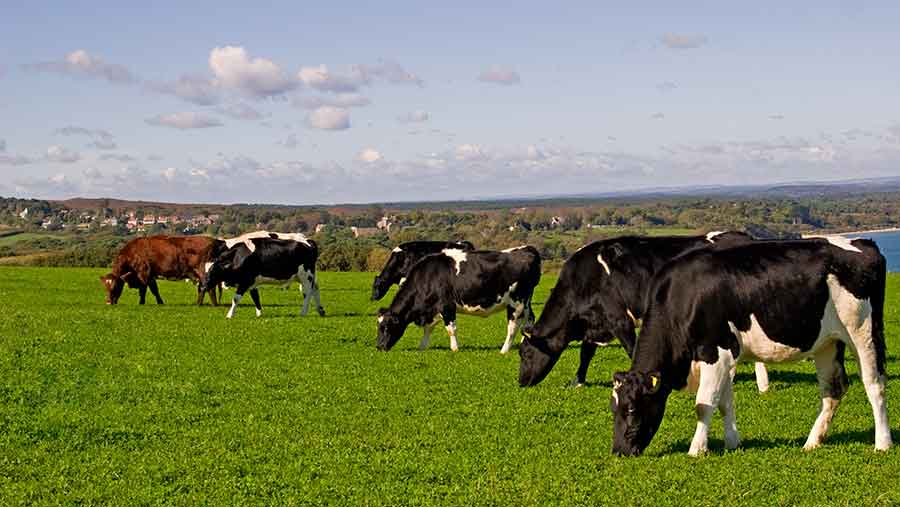Clover yields extra milk worth £630/ha, study shows
 © Nicholas and Sherry Lu Aldridge/FLPA / imageBROKER/REX/Shutterstock
© Nicholas and Sherry Lu Aldridge/FLPA / imageBROKER/REX/Shutterstock Feeding spring-calving cows grass clover can increase milk solids by 58kg a cow throughout the lactation, resulting in an additional €232 a cow (£200), a three-year Teasgasc study has found.
Researchers at Clonakilty Agricultural College, County Cork, say feeding a grass and white clover mix on the milking platform has resulted in an additional €720/ha (£630) because of the extra milk yielded when compared with feeding grass alone.
Lead researcher Brian McCarthy told delegates attending a tour to Clonakilty, one day ahead of the Positive Farmers conference on Tuesday, 10 January, that the difference in milk yield was driven by higher animal dry matter intakes, aided by higher-quality feed.
Advice for feeding clover
- Graze it down to 3.5-4cm
- Get nitrogen on early in the spring – aim to apply 70 units of N/ha by 1 April
- Stick to your spring rotational planner
- Aim to graze 30% by 1 March, 60% by 17 March and 100% by 4 April
- Graze the grass at low covers (500-600kg DM/ha) if clover content is high to stimulate the swards
See also: Clover rewards with faster lamb growth at Dinas Island
Positive Farmer’s conference co-founder Mike Murphy believes the research is “the most valuable experiment” he has seen in his lifetime.
Nutrient breakdowns show grass clover analysed 24.4% crude protein compared with grass, which had a crude protein of 19.1%. Neutral detergent fibre was lower in grass clover at 44.2%, compared with 50% in grass-only swards.
Dr McCarthy says: “This means the fibre in the rumen doesn’t take as long to break down and passes through the rumen faster, driving intakes.”
About the trial
As part of the experiment, 30 cows were rotated around four areas made up of 20 paddocks. The four areas were sown with one of the following:
- Tetraploid sward
- Diploid sward
- Tetraploid sown with 2kg/acre of clover
- Diploid sown with 2kg/acre of clover.
Cows were stocked at 2.75/ha and nitrogen was applied at 250kg N/ha across all areas.
Animals entered paddocks at grazing covers of 1,300-1,500kg DM/ha and swards were grazed down to heights of 4cm, with a target of 300kg supplement fed a cow.
Results over the three-year period (from 2014-2016) showed:
- Clover swards grew an additional 12kg DM/ha on average compared with grass-only leys, resulting in an extra 1.5t DM/ha
- The tetraploid clover mix grew slightly more than the diploid clover ley at 17.1t DM/ha compared with 16.9t DM/ha, although researchers said this was not significantly different
- Milk yield was 728kg a cow higher on average in the groups fed clover grasses. However, butterfat and protein levels remained relatively static
- Milk solids a cow were 58kg higher in the diploid clover- and tetraploid clover-fed groups
- Milk solids were 159kg/ha higher overall in the groups fed clover compared with those fed straight grass
- Over the 45-week lactation the extra milk produced resulted in an extra €232 a cow (£200) and €720/ha (£630) (with a milk price of €0.31/litre (£0.27).
Advice for beating bloat
Bloat is a build-up of froth in the rumen that a cow can’t expel. The risk is typically higher on a clover diet because the rumen is working faster and gases are being produced quicker than the cow can expel them. Here are some steps to beat it:
- Use bloat oil in dry weather, when water intakes will be high, as a preventative measure. Put 30-60ml a cow a day into tanks 12-24 hours before cows enter clover paddocks. It must be drip-fed so cows don’t drink it all at once.
- Restrict access to high-clover content paddocks by grazing them behind a wire in three- to 12-hour slots.
- Skip paddocks with high content clover (>50%).
Disadvantages of feeding clover
One main disadvantage to the grass clover leys was grazing deficits in the spring caused by poor winter growth. This resulted in a difference in opening farm covers of 267kg DM/ha between grass-only and grass clover paddocks in 2015-16.
On average, grass clover leys grew at 2-2.5kg DM/ha over the winter, but grass almost doubled this at 5kg.
“Some of the clover paddocks lost cover over the winter if they had a high clover content,” explains Dr McCarthy.
This meant cattle on these paddocks had to be housed by night for four to six weeks at the beginning of the season in February and March.
Over these two consecutive seasons cows were fed 145kg DM extra silage an animal – roughly the equivalent of a bale, which costed an extra £30 a cow.
However, despite the extra costs in early spring, which amounted to €46 a cow (£40) for extra labour, seed, feed and bloat prevention oil, overall net costs benefits still amounted to €594/ha (£522), according to researchers.
Furthermore, there are ways to limit spring grass growth deficits in clover leys, explains Dr McCarthy.
“If anything is losing clover [<30%], try to close them first so they grow well over the winter. Try to graze high-clover fields [>30%] at the end of the last rotation so you use the material that is there and it doesn’t have the chance to decrease.”
